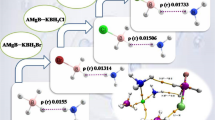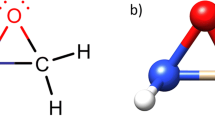Abstract
The geometrical structure and electronic properties of bis(10-hydroxybenzo[h]quinolinato)beryllium (Bebq2) molecule and its dimer both in the neutral and in the positively and negatively charged states were studied using quantum-chemical calculations. It is found that the excess charge in the charged systems is localized on one of the hydroxybenzoquinoline ligands. Structural changes in charged Bebq2 are pronounced in the charged ligand and nearly negligible in the neutral ligand. Charge transfer from the charged ligand to a neutral one can proceed either within a single Bebq2 monomer molecule or between the different monomers in the Bebq2 dimer. The corresponding hopping integrals were estimated as half the excitation energy from the ground to the first excited state of either the monomer or the dimer calculated at the avoided crossing point.

Charge localization and charge transfer in the Bebq2 monomer and dimerᅟ




Similar content being viewed by others
References
Hamada Y, Sano T, Fujita M, Fujii T, Nishio Y, Shibata K (1993) High luminance in organic electroluminescent devices with bis(10-Hydroxybenzo[H]Quinolinato)Beryllium as an emitter. Chem Lett 22(5):905–906. doi:10.1246/Cl.1993.905
Hamada Y, Sano T, Shibata K, Kuroki K (1995) Influence of the emission site on the running durability of organic electroluminescent devices. Jpn J Appl Phys 34(7A):L824–L826. doi:10.1143/Jjap.34.L824
Lee JH, Lin TC, Liao CC, Yang FH (2005) Study on organic light-emitting device with more balanced charge transport. Proc Soc Photo-Opt Inst 5632:220–225. doi:10.1117/12.576013
Hamada Y (1997) The development of chelate metal complexes as an organic electroluminescent material. IEEE Trans Electron Devices 44(8):1208–1217. doi:10.1109/16.605456
Hamada Y, Sano T, Fujii H, Nishio Y, Takahashi H, Shibata K (1997) Organic light-emitting diodes using 3- or 5-hydroxyflavone-metal complexes. Appl Phys Lett 71(23):3338–3340. doi:10.1063/1.120330
Liu SW, Huang GJ, Lee CC, Chen CT, Wang JK (2007) Bipolar charge transport and electroluminescent properties of bis(10-hydroxybenzo[h]qinolinato) beryllium: dependence on deposition rate. In: Proceedings of the International Display Manufacturing Conference, pp 394–395
Park TJ, Jeon WS, Park JJ, Kim SY, Lee YK, Jang J, Kwon JH, Pode R (2008) Efficient simple structure red phosphorescent organic light emitting devices with narrow band-gap fluorescent host. Appl Phys Lett 92(11). doi:10.1063/1.2896641. Artn 113308
Tsuboi T, Jeon WS, Kwon JH (2009) Observation of phosphorescence from fluorescent organic material Bebq(2) using phosphorescent sensitizer. Opt Mater 31(12):1755–1758. doi:10.1016/j.optmat.2008.07.017
Lee JH, Liu SW, Huang CA, Yang KH, Chang Y (2004) High brightness and long lifetime OLED with mixing layer technology. In: Heremans PL, Muccini M, Hofstraat H (eds) Organic optoelectronics and photonics, book series: proceedings of the society of photo-optical instrumentation engineers (SPIE), 5464 434–440
Lee CC, Liu SW, Chung YT (2010) Effect of deposition rate on device performance and lifetime of planar molecule-based organic light-emitting diodes. J Phys D Appl Phys 43. doi:10.1088/0022-3727/43/7/075102
Liu SW, Lee CC, Wang CH, Lee JH, Chen CT, Wang JK (2009) Enhancing performance of planar molecule-based organic light-emitting diodes through deposition-rate optimization: role of molecular packing. Chem Phys Lett 474:207–211. doi:10.1016/j.cplett.2009.04.013
Wong CY, Woollins JD (1994) Beryllium coordination chemistry. Coord Chem Rev 130(1–2):243–273. doi:10.1016/0010-8545(94)80006-5
Newton MD (1991) Quantum chemical probes of electron-transfer kinetics: the nature of donor–acceptor interactions. Chem Rev 91(5):767–792. doi:10.1021/Cr00005a007
Coropceanu V, Cornil J, da Silva DA, Olivier Y, Silbey R, Bredas JL (2007) Charge transport in organic semiconductors. Chem Rev 107(4):926–952. doi:10.1021/Cr050140x
Grimme S (2004) Accurate description of van der Waals complexes by density functional theory including empirical corrections. J Comput Chem 25(12):1463–1473. doi:10.1002/Jcc.20078
Grimme S (2006) Semiempirical GGA-type density functional constructed with a long-range dispersion correction. J Comput Chem 27(15):1787–1799. doi:10.1002/jcc.20495
Grimme S, Antony J, Ehrlich S, Krieg H (2010) A consistent and accurate ab initio parametrization of density functional dispersion correction (DFT-D) for the 94 elements H–Pu. J Chem Phys 132(15). doi:10.1063/1.3382344
Neese F (2012) The ORCA program system. WIREs Comput Mol Sci 2:73–78. doi:10.1002/wcms.81
Schafer A, Horn H, Ahlrichs R (1992) Fully optimized contracted gaussian-basis sets for atoms Li to Kr. J Chem Phys 97(4):2571–2577. doi:10.1063/1.463096
Mori-Sanchez P, Cohen AJ, Yang WT (2008) Localization and delocalization errors in density functional theory and implications for band-gap prediction. Phys Rev Lett 100(14). doi:10.1103/Physrevlett.100.146401
Cohen AJ, Mori-Sanchez P, Yang WT (2012) Challenges for density functional theory. Chem Rev 112(1):289–320. doi:10.1021/Cr200107z
Johnson ER, Mori-Sanchez P, Cohen AJ, Yang WT (2008) Delocalization errors in density functionals and implications for main-group thermochemistry. J Chem Phys 129(20). doi:10.1063/1.3021474
Zhao Y, Truhlar DG (2011) Density functional theory for reaction energies: test of meta and hybrid meta functionals, range-separated functionals, and other high-performance functionals. J Chem Theory Comput 7(3):669–676. doi:10.1021/ct1006604
Goerigk L, Grimme S (2011) A thorough benchmark of density functional methods for general main group thermochemistry, kinetics, and noncovalent interactions. Phys Chem Chem Phys 13(14):6670–6688. doi:10.1039/c0cp02984j
Smith JM, Alahmadi YJ, Rowley CN (2013) Range-separated DFT functionals are necessary to model Thio-Michael additions. J Chem Theory Comput 9(11):4860–4865
Jacquemin D, Moore B II, Planchat A, Adamo C, Autschbach J (2014) Performance of an optimally tuned range-separated hybrid functional for 0–0 electronic excitation energies. 10(4):1677–1685. doi:10.1021/ct5000617
Mardirossian N, Head-Gordon M (2014) ωB97X-V: a 10-parameter, range-separated hybrid, generalized gradient approximation density functional with nonlocal correlation, designed by a survival-of-the-fittest strategy. 16(21):9904–9924. doi:10.1039/c3cp54374a
Tentscher PR, Arey JS (2013) Binding in radical-solvent binary complexes: benchmark energies and performance of approximate methods. J Chem Theory Comput 9(3):1568–1579. doi:10.1021/ct300846m
Grimme S, Ehrlich S, Goerigk L (2011) Effect of the damping function in dispersion corrected density functional theory. J Comput Chem 32(7):1456–1465. doi:10.1002/Jcc.21759
Granovsky AA (2011) Extended multi-configuration quasi-degenerate perturbation theory: the new approach to multi-state multi-reference perturbation theory. J Chem Phys 134(21). doi:10.1063/1.3596699
Granovsky AA, Firefly version 8.0, www http://classic.chem.msu.su/gran/firefly/index.html
Schmidt MW, Baldridge KK, Boatz JA, Elbert ST, Gordon MS, Jensen JH, Koseki S, Matsunaga SN, Nguyen KA, Su S, Windus TL, Dupuis M, Montgomery JA (1993) J Comput Chem 14(11):1347–1363. doi:10.1002/jcc.540141112
Hsu CP (2009) The electronic couplings in electron transfer and excitation energy transfer. Acc Chem Res 42(4):509–518. doi:10.1021/Ar800153f
Koh SE, Risko C, da Silva DA, Kwon O, Facchetti A, Bredas JL, Marks TJ, Ratner MA (2008) Modeling electron and hole transport in fluoroarene-oligothiopene semiconductors: investigation of geometric and electronic structure properties. Adv Funct Mater 18(2):332–340. doi:10.1002/adfm.200700713
Difley S, Wang LP, Yeganeh S, Yost SR, Van Voorhis T (2010) Electronic properties of disordered organic semiconductors via QM/MM simulations. Acc Chem Res 43(7):995–1004. doi:10.1021/Ar900246s
Gao HZ, Zhang HY, Zhang HY, Gen Y, Su ZM (2011) Theoretical study of isomerism/phase dependent charge transport properties in tris(8-hydroxyquinolinato)aluminum(III). J Phys Chem A 115(33):9259–9264. doi:10.1021/Jp202976m
Nan GJ, Wang LJ, Yang XD, Shuai ZG, Zhao Y (2009) Charge transfer rates in organic semiconductors beyond first-order perturbation: from weak to strong coupling regimes. J Chem Phys 130(2). doi:10.1063/1.3055519
Wu Q, Van Voorhis T (2005) Direct optimization method to study constrained systems within density-functional theory. Phys Rev A 72(2). doi:10.1103/Physreva.72.024502
Acknowledgments
The authors are grateful to Dr. A. Freidzon personally for useful discussions. Financial support from the Ministry of Science and Education of the Russian Federation (project No. 16.523.11.3004) is greatly appreciated.
Author information
Authors and Affiliations
Corresponding author
Rights and permissions
About this article
Cite this article
Safonov, A.A., Bagaturyants, A.A. Charge localization and charge transfer in the Bebq2 monomer and dimer. J Mol Model 20, 2397 (2014). https://doi.org/10.1007/s00894-014-2397-z
Received:
Accepted:
Published:
DOI: https://doi.org/10.1007/s00894-014-2397-z




